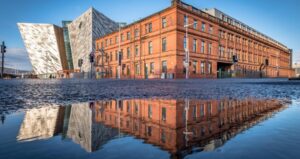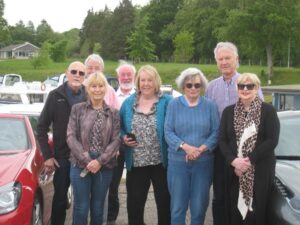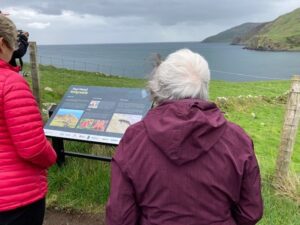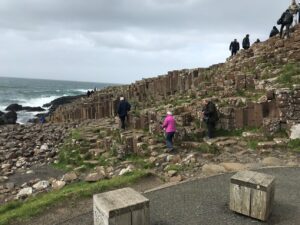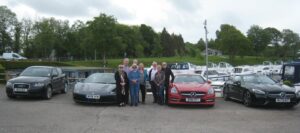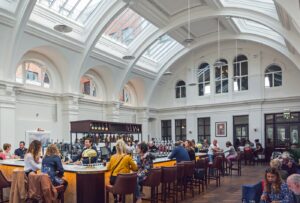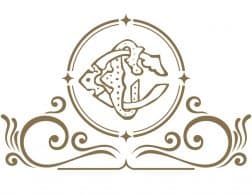Clifton Club Petrolheads visit to Northern Ireland
Eight Club Petrolheads crossed the Irish sea in early May for a tour of Northern Ireland. None of us knew what to expect. It turned out to be a voyage of discovery and full of unexpected and pleasant surprises.
The ferry from Liverpool arrived in Belfast at 6.30 am so the first day was an early start. After refueling with a hearty breakfast in the lee of Carrickfergus Castle which protected the estuary into Belfast in times of old, the convoy set off on the spectacular Causeway Coastal Route round the rocky and unforgiving north east coastline of the island.
The narrow roads hug the cliff edge and teeter round the tiny bays below for 50 miles of spectacular scenery. The first surprise was the number of coastal castles that we passed. Ireland in the middle ages must have felt in constant danger of invasion.
The first stop was the Carrick-a-Rede rope bridge, rebuilt each year right up to the mid 1960s, to bring the salmon catch ashore from a small island a few yards offshore. The fishery required huge physical effort to bring the catch to land and was unbelievably dangerous for all those involved. I wonder if any of the people who ate the fish had any idea of the human cost of getting it to them?
A few miles later the scale of the Giants Causeway was the second surprise. Acres and acres of hexagonal columns sprouting through the rock, all looking smooth enough to have been cut with a saw.
And so to Londonderry and our hotel for two nights, avoiding along the way the crowds and traffic attending the motorcycle road races being run on the country roads between Portstewart and Portrush.
Londonderry in the middle ages was a similar sized walled city to Bristol, prosperous and trading internationally from the banks of a river estuary. The Londonderry walls are still complete which we walked round with a stop halfway for lunch. Looking north from the walls into the Bogside surprised us with how small the area is (about 800 yards by 300 yards) and how close it is to the centre of the city. The Troubles must have been terrifyingly close to all the citizens of Londonderry and totally unavoidable.
The next day we moved south and west to Enniskillen, another beautiful small county town at the southern end of enormous Lough Eme. Our hotel was a few miles north on the side of the lough – a beautiful Georgian house with spectacular views, fabulous and willing service, lovely rooms and a first class kitchen.
There was a marina for 200 boats with a bare boat charter fleet of 20 or so really desirable sailing and motor yachts in the lough in front of the hotel. The seafarers and would-be Captain Pugwashes amongst us compromised by hiring a day boat for a few hours to explore the beautiful lough.
Day six took us to Belfast and the Titanic Hotel in what used to be the headquarters building and drawing offices of Harland and Wollf shipbuilders. It’s a wonderful location and a brilliantly adapted historic building.
There was a marina for 200 boats with a bare boat charter fleet of 20 or so really desirable sailing and motor yachts in the lough in front of the hotel. The seafarers and would-be Captain Pugwashes amongst us compromised by hiring a day boat for a few hours to explore the beautiful lough.
Day six took us to Belfast and the Titanic Hotel in what used to be the headquarters building and drawing offices of Harland and Wollf shipbuilders. It’s a wonderful location and a brilliantly adapted historic building.
The bar is in the enormous Drawing Office No 1 and the dining room in the equally enormous Drawing Office No 2. We could almost touch the history as we sipped our glasses of Guinness, Bushmills whisky and assorted colours of wine.
The general agreement was that whole journey would have been worthwhile for our visit to the spectacular and recently opened Titanic Museum, a few yards from the Harland and Wollf headquarters, which is now the Titanic Hotel.
The museum is a remarkable telling of the history of Belfast, its shipbuilding industry and the building of the Titanic ocean liner in particular. Even the non-mechanically or industrially minded members of the party were bowled over by their visit.
It was a wonderful bookend to a week of gentle pottering around and serendipitous exploring that had exceeded all our expectations.
And so back to Liverpool on the overnight ferry to be faced with the slog back home down M6 and M5. But someone’s got to do it!
Words by Richard Jarrett
